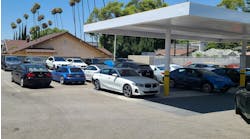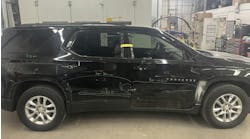With the right guidelines, PDR can offer you some profitable roof repair remedies
Is PDR a good choice for comprehensive roof repair? In many instances, the answer is yes. And even when PDR cannot address the entire damage situation, it may sometimes be utilized in combination with the conventional approach to achieve a repair that satisfies the customer, the body shop manager and the insurance company.
PDR is a decades-old process that reforms metal back to its original condition without sanding, filling or painting. PDR is commercially used to repair dents, dings, creases and hail damage on vehicles without damaging the integrity of the paint finish. Working from behind the panel, technicians use specially designed tools to massage the metal back to its original shape.Advancements in PDR techniques, training and tooling have made possible more complex, difficult repairs such as creases, body lines and hail damage. Most insurance companies and remarketing professionals view PDR as a highly acceptable repair method. Several automotive manufacturers have issued repair guidelines for PDR.
The severe hailstorm: challenge and opportunity for nearby body shops
Hail is a frequent cause of vehicle roof damage. And when a densely populated area experiences a major hailstorm, the magnitude of damage to vehicles often is enormous. When a hailstorm hit Tulsa in early June 2008, for example, the Associated Press cited State Farm reports of about 2,500 automotive claims from the area, totaling about $6.25 million in damage. In addition to such individual driver claims, the total vehicle repair needs for an affected area also will usually include dealer and rental company inventory vehicles, government vehicles, public transportation buses and vans, and business delivery trucks.A vehicle roof with dozens of hail dents may look like a lost cause, but it is likely that the dents can be repaired with PDR. The number of dents is usually not a factor in the applicability of PDR, but the size of the dents is a consideration, especially when the hail exceeds baseball-size. When hail stones of that size combine with a storm that has high winds, typical vehicle damage is likely to necessitate replacement of roofs.
The good news is that the majority of hail is smaller than two inches in diameter, producing dents that can be removed with PDR. In such a situation, PDR affords many advantages. Even a roof with more than 200 dents may require only a couple days of PDR work to look like new, helping to ensure customer satisfaction in terms of both the quality of work and the convenience of the service. The financial savings are often substantial in comparison with the traditional paint and putty method.
In addition, the vehicle will leave the shop in better condition because the best paint for the vehicle is the original paint applied by the manufacturer. Replacement paint will be less durable and will leave the vehicle more susceptible to future issues such as fading and rust.
Even in situations requiring some traditional repair work, PDR may still have applicability. While damage may be too great for PDR to entirely eliminate dents, it may be possible to achieve 75 to 95 percent correction of the damage. From there, the body shop technician would apply a light coat of filler and paint over the damaged area. If painting is inevitable, this combination approach affords time and cost savings and produces a good final appearance.
There are no specific guidelines for implementing combination work. Situations in which it is a possibility often are rare. Where PDR appears to be almost, but not quite the appropriate repair method, it is often useful for the body shop and the PDR vendor to evaluate the damages together and discuss their perspectives on the pros and cons of each option. If combination work is the agreed-upon choice, detailed planning should specify the percentage of "push to prep" (correction of dents) expected from PDR.
Vehicle roofs and accidents
Vehicle roof damage seen following an accident is often the result of a rollover crash. In a rollover situation, the roof damage would normally be beyond the capabilities of PDR to address. There are, however, situations in which small roof dents can occur during an accident and afterward be eliminated with PDR.
If the vehicle is considered salvageable it will be worthwhile to check with your PDR vendor to see if PDR can be used to repair the vehicle roof.
Choosing a PDR vendor
For many body shops, the dilemma of identifying the right PDR vendor comes on fast and hard, much like large hail raining down. Even if a shop already has a local PDR technician who provides service for a few hours a week, the magnitude of repairs needed after a hailstorm may often be far beyond what one tech can handle and still maintain his core business. Contracting with a firm that can bring a number of qualified PDR technicians to the area quickly will make it easier to maximize the opportunity for your shop and serve the many customers needing repairs. Without the assistance of a temporary vendor, the shop may miss a revenue-generating opportunity, as well as the chance to demonstrate its good service to customers who previously have not needed body work.
Despite the small window of time for selecting a vendor and getting its techs in place following a hailstorm, it is critical to ensure that important questions have been answered. Getting the best value and performance from PDR service is key to maximizing the opportunity. Points to consider include:
- Training and capabilities of the PDR technicians. PDR is a craft that requires extensive training to develop a high skill level. Technicians should have demonstrated capability of providing repairs without impacting the integrity of the paint finish or the manufacturer warranty. Documentation of their qualifications should be provided.
- Quality of work. Not all PDR vendors provide the same quality of work. Lower-quality work may cost less, but a top-quality PDR job ensures customer satisfaction, which can impact retention rates. In addition to doing excellent work, in a high-volume situation it is particularly important that technicians also work efficiently. See what information a vendor can provide about the quality of its work.
- Insurance carried by the PDR vendor. Make certain that the program is insured should the provider go out of business or in case a vehicle is damaged or any problems arise while technicians are working in your shop.
- Warranties. Is there a warranty on PDR work provided by the vendor?
- Sufficient emergency support. In the post-hailstorm situation, can the vendor furnish enough qualified PDR technicians within a couple of days to work on the vehicles that your shop has the opportunity to repair? If demand is even larger than expected, can the vendor send in additional technicians to help?
- Physical set-up. Can the vendor set up a retail hail damage repair site in a timely manner? If necessary, can the vendor provide tents and work outdoors under them? While not ideal, in a high-volume situation this type of set-up may make it possible to service a much larger number of vehicles in a short period of time, while enabling your shop to continue with regular work as needed.
- Realistic job estimating to get vehicles back to their original conditions. With major dent damage, a quick-and-dirty estimating job can be way off the mark. Even a simple step like checking a vehicle outside in the sun can make a major difference. If the roof of a car has 60 dents, 60 roof dents should be listed on the estimate. Ask for specifics on how the PDR vendor prices jobs.
- Referral business potential. If the PDR vendor can bring a significant amount of business into your shop, that business will be "gravy" in terms of your overall profit from the hailstorm PDR operation. Several factors can contribute to a vendor's potential in this area, including local relationships with insurers and other relevant businesses, as well as toll-free number referrals if the vendor is a national or regional company. Documentation of third-party relationships is a key factor to look for, as is referral lead generation data.
- Buttoned-up invoicing. What information will the vendor provide on its invoices? If all points of potential concern to insurance companies are covered on each invoice, that thoroughness will save you the trouble of responding to a lot of questions.
Final word
Many PDR companies that provide emergency service for high-volume, catastrophe situations will make their hail operations staff available for questions and service planning throughout the year. It's worthwhile to learn more about these companies before the next storm passes through your city.
Mike Morrison is vice president of hail operations with Dent Wizard International. For more information, visit www.dentwiz.com.



